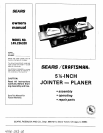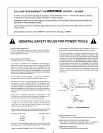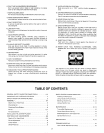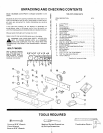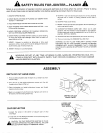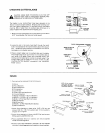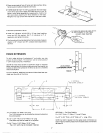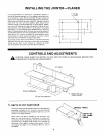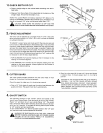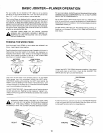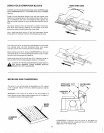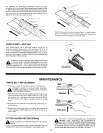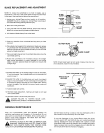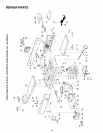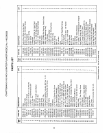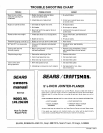
USING HOLD DOWN/PUSH BLOCKS
ALWAYS use the hold down/push blocks when JOINTING wood
that is NARROWER than 3 in. or PLANING wood that is THINNER
than 3 in.
Grasp the hold down/push blocks firmly with the fingers close
together and wrapped around the handle. Position them flat on
top of workpiece, and push the workpiece down against the
table to provide a quality cut and minimize the chance of a kick-
back.
Hold down pressure must be sufficient to prevent hold down/
push block from sliding or slipping on the surface of the work
piece when advancing work piece over cutter head.
Use a hand-over-hand motion of the hold down/push blocks
being careful to maintain control of the workpiece at all times.
HAND-OVER HAND
/
/
This means that once the work piece has passed the cutter head
onto outfeed table, one hold down/push block must always
maintain contact with the work piece with outfeed table.
When planing wood 3/4 in. thick and NARROWER than the hold
down/push block, tilt the hold down/push block so that it clears
the top of the cutter guard while feeding.
Never plane wood that is thinner than 1/2 in.,.because it is apt to
split or shatter and thus has a greater tendency to kickback.
_CAUTION: DOWN/PUSH BLOCKS TEND TO
IF THE HOLD
SLIP WHILE FEEDING, CLEAN RUBBER SURFACE
IMMEDIATELY WITH SANDPAPER.
BEVELING AND CHAMFERING
The fence on your jointer-planer is adjustable from 45 ° inboard
to 45 ° outboard. Adjust the fence to desired angle and tighten
lock knobs.
BEVELING is the cutting of. an angle on the entire edge of a
board, Beveling may require several passes due to the depth of
cut needed to bevel entire edge of board.
OUTBOARD
TILT-_
BEVEL
EDGE
CHAMFER
EDGE
11
CHAMFERING is removing only the corner of the edge of a
board. Normally a chamfer is made with one cut; therefore, a cut
deeper than 1/16" may be made.
I



